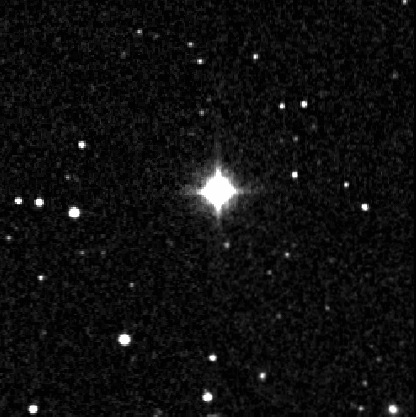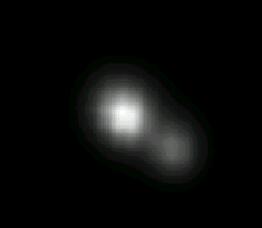
| " " |
|
| Facilities Research Publications Patents Astronomy Software SSC Observatories Contact Us | |
Double StarsSSC Observatories April 2004 Until the early 20th century, scientific astronomy consisted mostly of Atrometry. In short, astronomy was mostly mapping out the night sky with as much accuracy as possible. Kepler and Newton had unraveled the forces that governed celestial motion, and diligent observers were filling in the details. With the beginning of 20th century, George Ellery Hale and his contemporaries, revolutionized astronomy by turning observational astronomy into a tool for studying physics. The birth of astrophysics and the fruits that it has born have changed the way in which we perceive the universe inhabit. But old positional astronomy has languished. With the exception of the U.S. Naval Observatory, the Hipparcos satellite mission and a few schmidtt surveys, little dedicated position astrometry is being performed. There are some surveys that are collecting astrometric information, but these efforts, while fundamental to the advancement of the science, go unheralded.  Figure 1: 40 Year Blink of Double at 10:28:53 -02d49m40s Amateur astronomy has fallen under the same spell. Visual observers crave large apertures and peer at distant fuzzies tens of millions of light years away, search for new asteroids, comets or super novas, time variable stars and wait for chance occultations. This month I want to remind you of the fun and science available to all in the enjoyment of double and multiple star systems in our own galaxy. We are jaded by our sun's solitary orbit about our galaxy. Almost all stars form in clusters and many remain gravitationally bond in double or multiple systems. Seen through even small aperture telescopes, these pairs offer many opportunities to the observer, and observing is little affected by the presence or absence of the Moon. I have appended to this article an abridged list of some spring doubles selected from the Washington Visual Double Star Catalog (1984). The stars selected were chosen such that they are visible this spring from the northern hemisphere, both components are brighter than 10th magnitude and separated by at least 1.0 arc seconds. This criteria assures that they should all be separable on 4 inch or larger scopes, and many will be separable on scopes with apertures as small as 60mm. Further, they all are visible with the unaided eye through the telescope. These stars truly belong to the amateurs. They are simply too bright to be studied with large professional scopes. If anyone is going to observe them, it will be with small aperture scopes, and that means us! Because they are exceptionally bright, it also means that they can be imaged easily with web cams, uncooled astro imagers, video, digital still cameras, or even unguided film photographs. What's To See? Another use for visual double stars is to judge the seeing conditions and the quality of your optics. Select a set of stars with progressively smaller separations. As you work down the list, you will get to a point where you can no longer separate the stars. This often gives you an idea of what the seeing conditions are on a given night. As you get down to the seeing limit, it is a good time to swap through you eyepieces and see which ones work well and which ones you might consider upgrading if they are not cutting it. Data Mining and Imaging http://archive.stsci.edu/cgi-bin/dss_form. When you retrieve the fields, you can get images from both the first and second Palomar Sky Surveys. The first survey was conducted in the mid 1950's and the second in the mid 1990's. As a result, the images are spaced by about 40 years. Your image will be spaced out by another 10 years. If you have almost any of the popular image processing software, anything from a photo program to a high end astronomical image processing system, you should be able to scale and align the images. Compare the images carefully. The best method is to blink compare them if you have the software. If not, print them in negative on plain paper and stack them and look at them on a light table, or put them on window so the light shines through all the pages. With luck you will notice that some stars line up and some do not. The ones that do not, have high proper motion. This can be caused by several things. Usually, stars with high proper motions are relatively close to us, on the order of a few tens of light years, or they are in orbit around a common center of mass.  Figure 2: Forty year Blink of Close Double at 12:57:25 +30d22m33s Double not well separated In DSS plates, but several bright high proper motion stars are apparent in the fields. Since you have three images, yours and the two survey images, you should be able to plot the direction of stellar travel. If the plot is a straight line, you either have a very long orbital period or stars that are just a chance juxtaposition of a background star and a star passing through in front of it. If you have a curve, then you have three points that must lie on projection of the ellipse of the orbit of a multiple star system! If you are lucky enough to have found an orbital pair, you can download a free copy of an astrometry program. My favorite is Astrometrica, a shareware program by Herbert Raab. The evaluation copy should be enough to get you started. It can be found at: http://www.astrometrica.at. The program will allow you to precisely measure the position of you stars to fractions of an arc-second with even modestly good images. This with a little trigonometry will allow you compute the orbit and the period of you star system.  The position current angle is 158.42 degrees, originally reported as 240 degrees.  Figure 5: HDS 3009 at 0.1115" Per Pixels 4/14/2004 In the example in Figure 1 above I have taken two images of a 7 arc minute field centered on 10:28:53 -02d59m40s and averaged them together after blink comparing them. In addition to the excellent 6 arc second double in the center of the frame, blink comparisons a shows a couple of stars to be, at the very least, high proper motion stars, and the two on the left hand side of the frame are suspected orbiting 14th magnitude orbiting double systems that do not appear in any of the literature. The catalog I have generated for spring has over 840 entries. It contains RA and DEC positions precessed to Epoch 2000.0 coordinates from the 1900 coordinates in the original catalogs followed by the magnitude of the first two components. Finally the separation in arc seconds at discover and the position angle at that time followed by the ADS catalog reference number if one exists. Follow this line to SSC's Spring Double Stars List. I have generated a complete list of bright double star candidates for the northern hemisphere along with additional columns showing the date of original discovery and cross reference to other catalogs. I have titled it the HDS Catalog and it is in a format that will allow it to be directly imported into Meades' Autostar Suite, Astronomical Softare or The Sky so that you can use it in popular planetarium programs.
|
|
|
|||